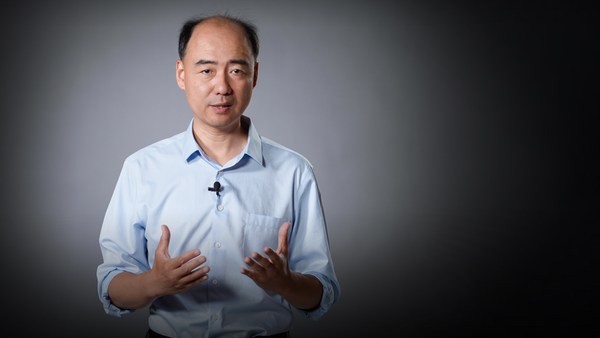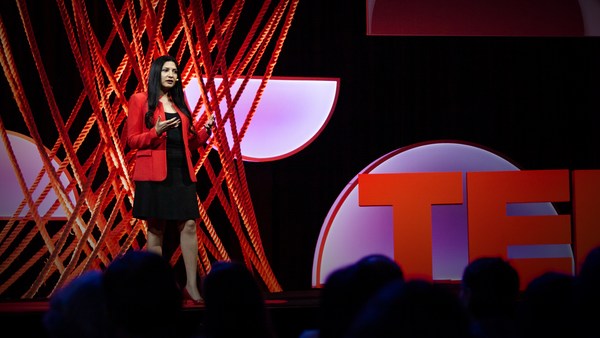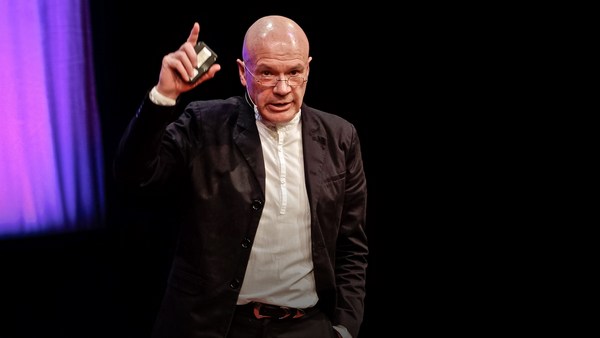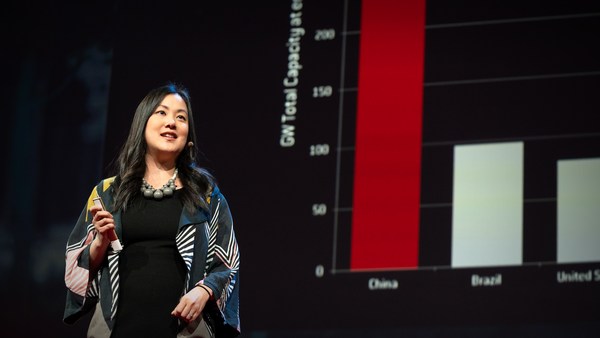So when I was born in China in the early 1980s, my country was still a place of scarcity. We lived on rationed food, cooked from communal kitchens and even in Beijing had three nights of blackouts every week. I remember reading poems with my father by candlelight. A special memory from times when Chinese people had little.
And fast forward three decades, China has turned into a country of abundance, especially when it comes to technological power. From high tech to business tech to everyday tech, there isn't anything you can't find, only things you can't imagine. I can buy a can of Coke by scanning my face. A few years ago, I called for toothpaste from my hotel room, and it was delivered to me by a robot. I've seen people live in remote Tibetan mountains blast off cool music with Walkmans powered by solar cells and Chinese solar technology light up homes for African kids who used to study by candlelight, just like me when I was growing up.
So this striking swell of innovation happened even though China remains a developing country, with just a little more than 10,000 dollars of per capita GDP. So today I want to offer you a different lens to look through, one that shows a unique model that has fostered innovation and technological growth.
Now the system is far from perfect. And like you, I worry about the rising tensions of a tech race and beyond. But I also believe that, as in any relationship, a better understanding of each other is going to help us more likely to find common goals to work on rather than a downward spiral that harms all.
So I'm an economist, straddling multiple worlds, as it turns out. One foot in London, where I do my research. And one foot in China, where I spend time with my family and also do a bit of work. And if I had a third foot, it would be in the US, where I was educated. So I can totally see why there's so much misunderstanding and incomprehension about this megacountry that has defied conventional wisdom.
So let's start out with how China's innovating. Now, innovation isn't just about inventing the next new thing, like the iPhone or 3D printing or sending people to Mars. Technologies that go from zero to one. It could be new applications, business models, better processes that lower costs. These one-to-n innovations are just as important. Whatever makes us leaner, cleaner and more productive, all count.
So TikTok might not be the first short-video app, but it has garnered more than a billion users around the world. The Chinese EV company, BYD, didn't make the first prototype. But compared to Tesla's price point, the 15,000-dollars EV cabs that I've taken with half a million kilometers of range can meaningfully lead to lower emissions and mass adoption. And in the same way, Chinese mobile phones might not be as revolutionary as iPhone, but in African countries, their market share is well over half.
So this actually solves one big problem for developing countries, which is the lack of access to suitable technologies that they can actually use. And even if China doesn't do many zero-to-one technologies yet -- at least not yet -- it doesn't mean that it can't master high tech, right? It conducted the first quantum video call, and it launched the first drone that can carry a passenger in air.
So let's go behind the scenes. Now, yes, many of you would say China's got money, markets, talent and troves of data, which is so critical in this information age. But it wasn't just that. Part of the success was also a "whole nation" approach, or what they call a "juguo" system. So turning an idea or scientific discovery into commercial success requires an innovation ecosystem. The collaboration of universities, national labs and industries, not to mention enormous amount of funding that covers long and uncertain investment cycles.
Now, many of you might think that groundbreaking technologies are the products of stars, the likes of Steve Jobs or Elon Musks. But every time you use the internet, the GPS or yell at your Alexa, you have the US government to thank for. We often forget that the Apollo program, the Manhattan Project, even Japan's rise to semiconductor stardom, were all horizontal systems with critical state backing.
Now, China's "juguo" system is an entire nation behind one strategic goal. Mobilizing national resources, casting the net wide, not tallying costs. And it’s the same system that’s used to reap as many Olympic gold medals as possible. And so thanks to this ecosystem, China became the largest consumer and producers of EVs in less than a decade. With more cars sold there than in the rest of the world combined in 2020.
Now in the West, we often talk about "nudging" consumers to make better choices. But in China, mass adoption of next-gen transportation happened like that. Well, in part thanks to the state rolling out four million charging stations around the country, coordinating supply chains from battery makers to control systems and manufacturers. Today, there are 140,000 chargers in the US in the entire country.
So that is kind of, the "whole nation" approach. But that's not actually the story I want to tell you. There's an even more nuanced story that happens on the ground. We call it the “mayor economy,” and it's a decentralized economic model that galvanizes creativity from the ground up. And contrary to popular perception, it isn't a centralized approach dominated by an almighty state.
And so here's how it works. So Nio is one of the top three EV companies in China. Its cars are driven everywhere on the streets of Beijing and Shanghai. Now, two years after it was listed on Nasdaq in 2018, it was on the verge of bankruptcy. Now, at this point, the local government of Hefei, a small town in eastern China with five million people, convinced it to move its headquarters there. The local government injected a billion dollars in exchange for a 25-percent stake, arranged more loans for the company and most importantly, organized an entire supply chain around Nio. It took only a year before Nio's production grew by 81 percent, its market cap went from four to 100 billion dollars. And the local government of Hefei cashed out within a year, and Nio's life was saved.
And so for every local government behind a Nio, there's another mayor behind a competitor. And there are literally hundreds of EV companies vying for survival in ruthless competition. So, if you are actually a promising tech company, local governments will move mountains to help. Remove red tape, check. Find you more financing, check. Get a job for your spouse, check. Piece of cake. They are a one-stop shop, as they like to call themselves. Now in the vigorous bid for Amazon's second headquarters, there were some creative offers. One state sent a giant cactus as a gift. Another state offered to rename a town Amazon. But it basically came to some tax breaks, not quite like what the Chinese mayors had to offer.
But of course, the US government is no stranger to supporting big-shot companies like SpaceX and Tesla, offering billions in benefits. But in China, it's really this marriage between hyper-charged local officials and intrepid entrepreneurs of all ilk that is at the heart of its model. And here's why. So the local government of Hefei, the one that made a killing with Nio, well, it wasn't just after the return on investment, per se. But it was by luring companies like Nio that it’s looking to create a mini Silicon Valley of sorts. An industrial clutter, a talent pool, a flourishing retail and service industry that gets them more jobs, more tax revenues. And guess what? Even the real estate and land they own are suddenly worth more, all because of the economics of agglomeration and multiplier effects, because the local mayors are actually an equity stakeholder of the entire city.
So in sum, it's this political centralization and economic decentralization that is actually a simple representation of China's model. It's the same model used to urbanize, to grow and now to innovate.
Now, for all of its successes, there were huge costs, I admit. Waste left in the wake, inefficient investments, wrong bets. Now, some of these challenges are being addressed, thankfully, like environmental degradation, but there are others that remain in urgent need of fixing. So I'm not suggesting that there's some universal recipe or that it's perfect or that it can be easily replicated. But what we do know is that there's more than one way of making things work. And recognizing that there is some wisdom to China's approach doesn't mean endorsing all of it. But I guess there's something to learn from each other. And for one, China didn't sit on the tarmac waiting for a technological takeoff. Instead, it was the big push from the ground up.
So I came to the US as an exchange student in 1997, and I was mesmerized. I saw enormous possibility between the East and the West, as they competed, collaborated and spurred each other forward. I still believe in this, even though frost has set in and there may be chill in the air for some time between the two largest economies in the world. Some may fear China's juggernaut innovation. Some may not like competition, which is rarely comfortable. But having someone in your rearview mirror helps you keep up the pace.
Japan's technological rise in the 1980s pushed the US to overhaul its innovation system and regain the lead in the 1990s. The US subsequently did the same for Japan, and as a result, we all have cheaper and better products. Today, Chinese EV company BYD is pushing Tesla to new heights and vice versa. Tesla opted for a Chinese battery maker, which is pushing the German government to do more in that space. And it's that mutual learning and constant threat of being overtaken that pushes the technology frontier further and beyond. But one thing's for sure, true, it just doesn't happen in geographical isolation.
So ... I’ve come here, and I imagine the possibilities between the two countries, and I understand that there are national security concerns that countries will have to respect. But not everything is about national security. The trillion dollars or more at stake with the economic disengagement between the two largest countries can do so much as eradicate malaria, end world hunger, conserve biodiversity and more. So let's not forget that there are more sacred things in life. Such as a brighter future for our children and a cleaner Earth. Let's not forget that in the developing world, there's still so much unnecessary misery. And that its people also have the right to enjoy the dignity in life as those who are more fortunate.
And so for all of this to happen, it seems to me that what we ultimately need is the cheapest and best technologies, rather than worry about where they come from or who will dominate.
Thank you.
(Applause)





